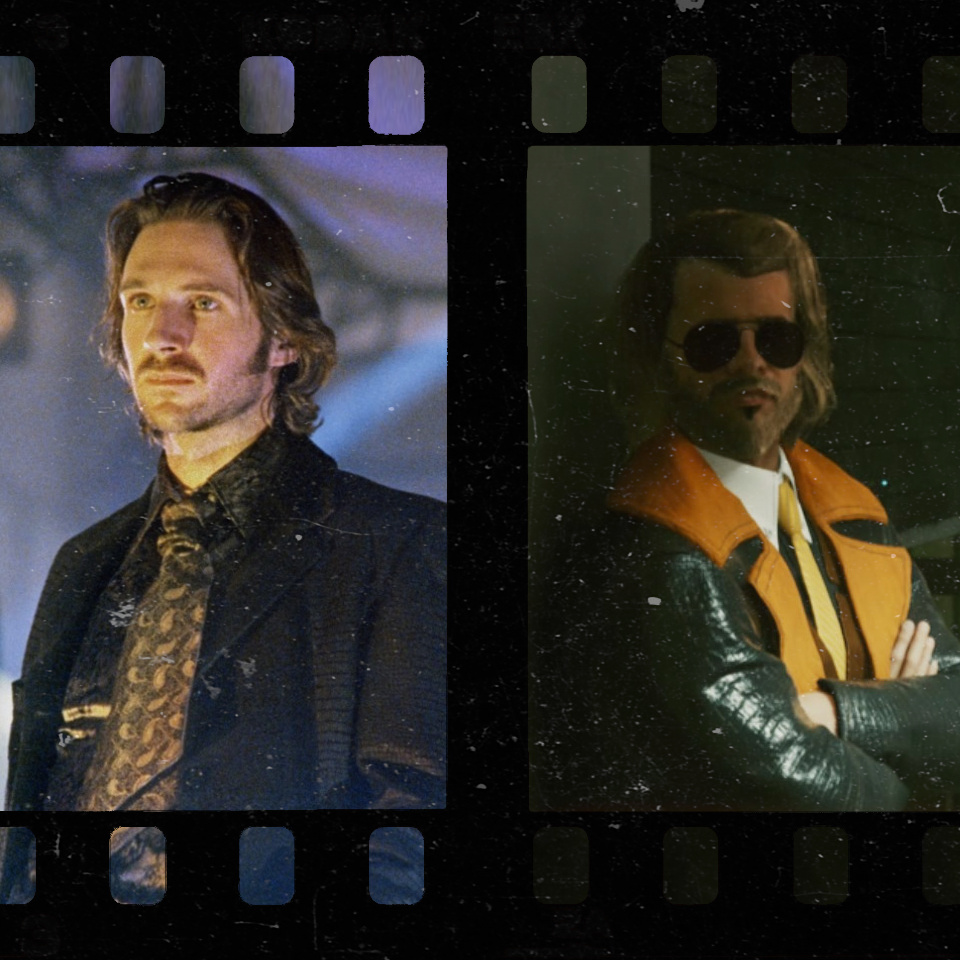Cut Scenes is Josh’s regular examination of the intersection between video game and film. This week, it’s Cyberpunk 2077 vs. Strange Days.
Strange Days is directed by Kathryn Bigelow and stars Ralph Fiennes as an ex-cop called Lenny Nero. Lenny is heavily stubbled and loosely coiffed, with trousers of creaky leather. We see him driving and talking on the phone, as the streets of Los Angeles boil over into violence. We are in the future, or we were. The film came out in 1995 and is set on the eve of the millennium, as the world is going out of its mind. But Lenny seems content to let the unrest seethe outside the car windows. He dangles a chunk of pizza, as the topping slides off, and slots it into his mouth while at the wheel. All things considered, Lenny is a slob.
We soon find out, however, that he is a slob in private pain. He makes a nocturnal living selling discs to eager and sweaty clients. These discs are wondrous things; tiny CDs entombed in a chunk of see-through plastic, they bring to mind the cassettes of the PlayStation Portable. I wish I could say that Lenny was busy plying a trade in imports, selling hot copies of Ridge Racer and LocoRoco, but he is, alas, selling memories. More specifically, recordings of experiences. These are captured with something called a S.Q.U.I.D. (short for Superconducting Quantum Interference Device), which looks like a slimy hair net. Lenny gets suckered into a conspiracy. He witnesses a depraved crime, and wields the freshly burned evidence, which certain interested parties are keen to douse.
Now consider Lenny’s second onscreen appearance, in Cyberpunk 2077. He sports the same greasy sweep of a haircut, and the same weakness for loud clothing, weighed down under a dark-green coat, with lapels the colour of egg yolk. The developer, CD Projekt Red, stashed him in the game by way of homage, and, presumably for legal reasons, he no longer looks or sounds like Ralph Fiennes. But he is still selling his product – getting people high on life, as it were. He offers Braindances: precisely the same concept, that of memories pressed onto slivers of plastic, only these ones are sealed into little squares of foil, like condoms. In a nice inversion, CD Projekt Red has Lenny selling “XBDs,” or extreme Braindances, which feature acts of barbarity and perversion. Bigelow’s hero, meanwhile, refuses such debasement. “God damn it! You know I don’t deal in snuff,” he says, after plugging himself into a video of someone who plummets from a rooftop. “I hate the zap when they die. It just brings down your whole day.”
The in-game Lenny loves it. He is perfectly happy to supply such zaps, lurking and smirking while the world tips into chaos. (Talk about LocoRoco.) What the developers at CD Projekt share with Bigelow is more than a mere gizmo. Rather, it’s a portal between interior and exterior space, a porous membrane between what we see and what we do. The setting of Cyberpunk 2077 is Night City, a sun-scalded babel, permanently on the brink of violence. During an early mission, the hero, V, drives through restless neighbourhoods; at a traffic light, he sees a carful of gun-toting criminals wiped out by the police. Compare the scene in Strange Days, in which the military prowls the avenues, clamping down on the riotous while Lenny munches his pizza. Like us, he’s a voyeur – passive, despite having his foot on the pedal. The windshield may as well be a TV screen.
The movie opens with an armed robbery. One of the crooks is wearing a S.Q.U.I.D., and Lenny relives the violence as though he were the one that triggered it. Similarly, in a mission entitled “The Information,” V scrubs through footage of a liquor store raid, gazing through the eyes of the gunman. If Bigelow was eager to take the temperature of a city still riven and raw, in the wake of the Rodney King beating and the riots that followed, CD Projekt probes the idea of passivity. V re-enacts the crime, looking for clues, and we, in turn, wind back and forth through the fevered act, feeling the zap, but what role are we playing? In other words, where do we go when we watch?
The answer depends on the person. For Lenny, he revisits the past; at home on his bed, he pines over S.Q.U.I.D. recordings of his former lover, Faith, wallowing in their intimate moments in a pained and longing loop. V, on the other hand, goes everywhere. His head becomes the semi-permanent residence of a digitised ghost, called Johnny Silverhand. This has many advantages, not the least of which is the presence of Mr Silverhand, played by Keanu Reeves, popping up and offering his commentary. V has visions of Johnny’s past, rife with anarchy and rebellion, but the kicker is that Johnny’s past is eating into V’s present, threatening to override one consciousness with another. Too much watching, in other words, and we lose ourselves. Bigelow arrives at a similar point. As someone warns Lenny, “This is your life, right here, right now. . . . Time to get real, not playback. . . . Memories were meant to fade.”






